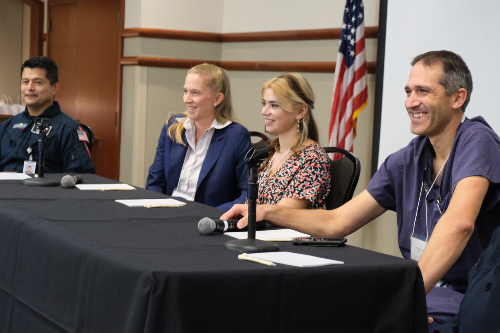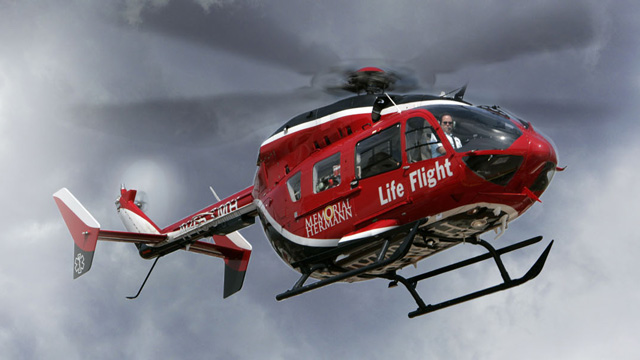
On the day of the accident, Tschen, then 16 years old, and three of her friends were headed home from a rabbit farm in Danbury, Texas, where Tschen was trying to get her grand champion show rabbit to breed. The breeding didn’t occur, and the breeder gave Tschen his buck so she could try again the next day. “I remember it as a very good day,” she recalls. “We were all very happy.”
"I didn't see the truck."
By the time they left, with Tschen at the wheel, it was dark. “I really don’t remember the accident all that well, just what people have told me,” she says. “I was making a left turn, and there was a blind spot. I didn’t see the truck.”
The driver’s side of Tschen’s car was stuck by a heavy-duty pickup truck hauling a horse in a trailer, traveling at an estimated 60 miles per hour. The driver and two passengers had just left the Brazoria County Fairgrounds, where they were roping horses. All three escaped injury.
Against her dad’s wishes, Tschen had placed her rabbit cage not in the trunk, as he had instructed, but in the back seat of her car, behind the driver’s seat. Tschen’s two girlfriends, Angie and Lainey, were sitting in the back seat, Angie in the middle and Lainey on the passenger side. “If Angie had been sitting behind me, she would not have survived,” says Tschen. Both girls sustained injuries but survived.
Seconds before impact, Tschen’s boyfriend, Matthew, sitting next to her, pulled her toward him. Tschen credits that action with saving her life.
It took local EMS over an hour, using the Jaws of Life to pull Tschen from the wreckage. Memorial Hermann Life Flight was standing by to transport her to Memorial Hermann-Texas Medical Center. Flight nurse Joel Benavides says Tschen was alert and oriented. “Prior to Life Flight’s arrival, she was in a lot of pain. EMS administered ketamine, which helped to resolve some of that. She had an open wound on her left femur, which we assumed was an open fracture. We applied a pelvic binder to support and stabilize her pelvis.”
In the air, the Life Flight team performed an ultrasound of Tschen’s chest and abdomen to look for internal bleeding and found none at that time. “We kept her hemodynamically stable and were able to transport her to the ER for further evaluation and treatment,” says Benavides
A Constellation of Traumatic Injuries
Stephen Warner, MD, PhD, assistant professor of orthopedic surgery at McGovern Medical School at UTHealth Houston and Memorial Hermann affiliated trauma orthopedic surgeon, says Tschen sustained “a constellation” of traumatic injuries that included a head injury resulting in concussion and brain bleed, broken ribs, a pneumothorax, fractured pelvis and an open femur fracture.
“One of the very advantageous aspects about being at a trauma center such as Memorial Hermann-TMC is the amount of subspecialty care available, which provides patients with such a high quality of care,” says Dr. Warner. Tschen’s head injury was cared for by the neurosurgery team, her lung injury by the trauma surgery team, and her pelvis injury and femur fracture by the orthopedic trauma surgery team.
Dr. Warner says the orthopedic team’s initial focus was to stabilize Tschen’s potentially life-threatening pelvis injury and to temporarily stabilize her open femur fracture using an external fixator. A few days later, when she was more clinically stable, they definitively stabilized her femur fracture with a rod and screws inside the femur.
A week and a half after Tschen was admitted, the trauma surgery team performed surgery to treat Tschen’s persistently collapsed lung. After several days spent in the ICU, she was released to inpatient physical therapy at a community hospital near her home.
A Team Sport
Dr. Warner describes trauma as a “team sport” and credits the first responders, including the local EMS agency and the Life Flight crew, with playing a critical role. “They are absolutely critical in their initial assessment and stabilization of patients and in getting patients from the prehospital setting into the hospital,” he says.
Dr. Warner also includes the patient and her family as an integral part of the team. “We can do everything we can to fix injuries the patient presents with,” he says, “but if the patient doesn’t have the right mindset, motivation and mental fortitude to overcome their injuries and to make a functional recovery, then the recovery’s going to be much more limited. Tschen was able to stay mentally strong and to deal with everything that occurred in such a formidable way, with the support of her family.”
In total, Tschen spent over a month in a hospital setting. Initially in a wheelchair, through hard work she graduated to a walker and then a cane. She returned to complete her junior year of high school after the Christmas break. And three years later, she is a marine biology major at Texas A&M Galveston.
She says it was easier for her to cope with the physical trauma than the emotional trauma. “I still feel some sadness,” she says. “The hardest part was the guilt, of putting my friends and boyfriend in that position.”
She says she has benefited from eye movement desensitization and reprocessing (EMDR) therapy, which she says helps her separate her emotions from the memory of it. And she says talking about her trauma with others also helps. After taking a public speaking course, Tschen spoke at the Red Duke Trauma Symposium in July 2022. She also shares her experience in casual settings with others who have undergone trauma.

Donate to Red Duke Trauma Institute
Please consider making a donation to the Red Duke Trauma Institute at Memorial Hermann-Texas Medical Center. No matter which area of the mission you support, your gift will make a lasting impact on patients and their families.
Donate NowRed Duke Trauma Institute Newsletter Sign Up
Use the form below to sign up to receive our Red Duke Trauma Institute Newsletter with helpful articles about our services, case studies relevant to clinical protocols practiced on a daily basis, information about available educational opportunities and many other updates for health care professionals and first responders.